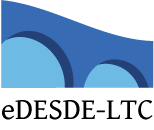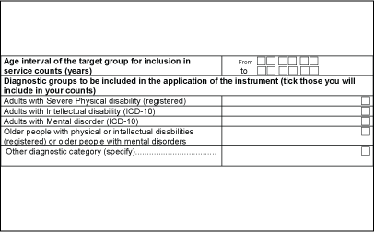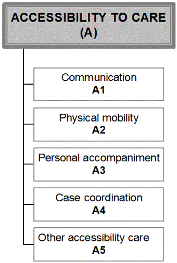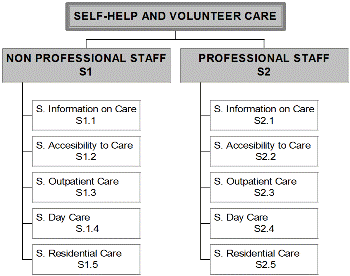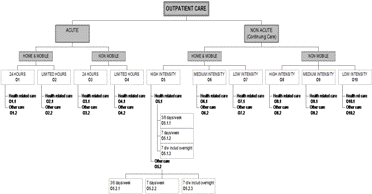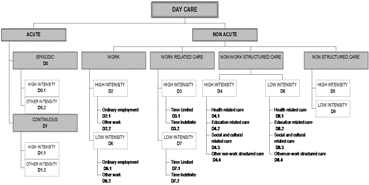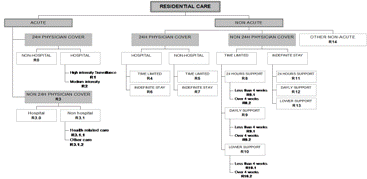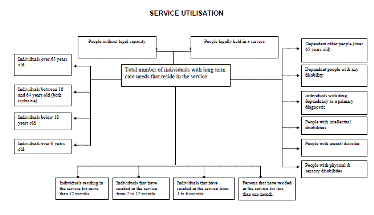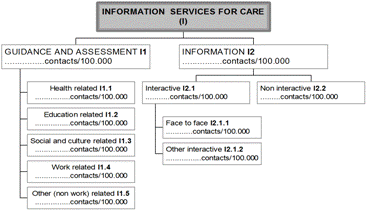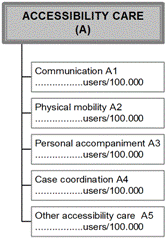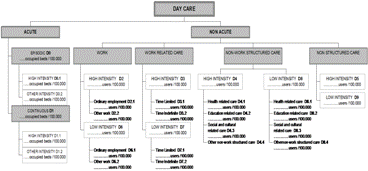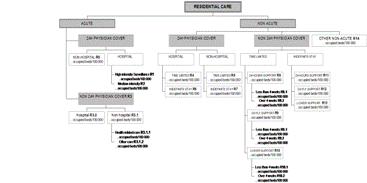home > eDESDE-LTC TOOLKIT > INSTRUMENT
INSTRUMENT
The ‘Description and Evaluation of Services and Directories in Europe for Long Term Care’ (DESDE-LTC) is an instrument for the standardised description and classification of services for Long-Term Care (LTC) in Europe.
It follows the approach to service evaluation developed by the EPCAT Group (European Psychiatric Care Assessment Team) and PSICOST Scientific Association since 1997, starting with the development of ESMS (European Service Mapping Schedule) for the evaluation of services in mental health (Johnson et al, 2000), and related adaptations to the evaluation of services for older people in Spain (DESDAE) (Salvador-Carulla et al, 2005) and services for disabilities (Salvador-Carulla et al, 2006).
This instrument is intended to compile service information on input and process at the meso (-level (health/social areas) and micro-level (individual services) as defined at a modified version of the Thornicroft & Tansella Matrix that was developed for the assessment of mental health care services (Tansella & Thornicroft, 1998).
DESDE-LTC allows the following tasks to be carried out in an standardised way:
- Compiling a standard directory of long term care services in a particular catchment area. This includes the provision of social services and health services by the public and voluntary sectors. Private sector is optional as it depends on the purpose of the analysis.
- Recording changes through time in services available within a specific catchment area.
- Delineating and comparing the structure and choice of LTC services in different catchment areas.
- Measuring and comparing the levels of provision/availability and utilisation of the Main Types Care (MTC) between different catchment areas using an international coding system.
- SECTION A: Catchment area mapping
-
INTRODUCTORY QUESTIONS. (TECHNICAL DATA OF THE STUDY)
- 1. Who has completed the schedule?
Name:
Profession:
e-mail:
Completion date: - 2. What is the reference date/time interval for completing the schedule?:
Reference month (i.e. from November 1st to Nov. 30th) or prospective census
From ../../…. To ../../….
Prospective census in one day: in ../../….
Prospective census in one week: ../../…. to ../../….
Prospective census in one month: ../../…. to ../../…. - 3. What sources of information have been used to complete the schedule?
- 4. Name and location of the catchment area
- 5. In which city, town or region (indicate as appropriate) and in which country is the catchment area?
- 6. What is the total size of its population?
- 7. How is the catchment area defined? (i.e. local government boundaries, health service sector, etc.) Please explain whether the the area follows census boundaries or not.
- 8. The default population to which the DESDE-LTC should normally be applied is the catchment area population of users with long term care needs over 18 years defined in page 4 (persons with severe physical disability, intellectual disability, severe mental disorders and elderly people with disabilities).
Collapse All - 1. Who has completed the schedule?
- SECTION B: Care type mapping (MTC Coding)
-
- a. PRINCIPLES FOR CODING LONG TERM CARE
-
- The aim of Section B is to produce a comprehensive categorisation of the facilities providing services for a defined target group in the local population, classified according to function, availability and setting.
- DESDE-LTC provides a list of services (BSICs) identified in each catchment area and the code assigned to them. This gives a quick vision of the availability of services and type of services. You can find this in the ‘Templates’ of DESDE-LTC Toolkit.
- DESDE-LTC has a glossary giving definitions of all terms used in the long term care mapping trees in the Guidelines for Coding LTC. Examples of services within each category and guidelines on categories that should be mutually exclusive are also given.
- There are six mapping branches for 1) information care 2) accessibility to care; 3) self-help and volunteer care; 4) outpatient care 5) day care, and 6) residential care. However, self-help and informal care are not included in the Service Counting Trees as it is assumed that activity volumes are not often documented precisely.
- The location in the tree of each BSIC is identified by a combination of a letter and a number: (i) a capital “I”, “A”, ”S”, “O”, “D” or “R” indicates whether the service is part of the information, accessibility, self help, out-patient, day and/or residential trees; (ii) within these trees, each final branch is given a number.
- OPTIONAL CODES. The DESDE-LTC coding can be complemented by optional codes which provide additional information on the service characteristics.
-Codes for the target population. These codes describe the main target group assisted in the service using capital letters before the core DESDE-LTC code.
-Age groups: “C” for Child & Adolescents (e.g. Day non-acute structured care for children C-D4); “A” for Adult and “E” for Elderly/Older people.
-Diagnostic groups: “SP” for Severe Physical disabilities; “ID” for Intellectual Disabilities; “MD” for Mental Disorders (ICD-10); “ED” for Elderly/older people with disabilities; and "MG" could be used for medical users without non further specification (generic).
For example: C[ID] – D1.1 for describing Day Acute Services for Child and adolescent with Intellectual Disabilities.
Services intended for ICD sections or for specific diseases can be coded using the corresponding ICD-10 code before the core DESDE-LTC coding.
- CODES FOR DESCRIBING ADDITIONAL CHARACTERISTICS. These optional codes have been incorporated to facilitate a quick appraisal of those characteristics of MTC and their related BSIC which may be relevant to local policy or for a specific research.
These codes are related to the general description of the service provided at Section "D", and therefore they are not part of the hierarchical tree structure of the DESDE-LTC system. These optional codes are small letters which can be added at the end of the numeral coding to provide an additional description about the location where the service is provided, special characteristics relevant for specific research, or the means by which the service is provided when this is a important descriptor (for example eHealth/telecare). Therefore they do not use cut-off points.
-"a" Acute care (complementary). This code describes acute care which is provided within a non-acute, non-residential setting (branches “O” and “D”) but which does not fit criteria for a separate MTC. As an example, this may be relevant to differentiate ambulatory facilities with the capacity to provide acute care as an ordinary activity from those ambulatory centres that do not provide acute care in a specific study of these services.
-"c" Closed care. This code describes secluded BSICs with high level of security which is provided under locked doors. Usually these units are for crime & justice users or persons with mental illness with high risk for themselves or others.
-"d" Domiciliary care. This code describes BSICs provided at the home of the user and nowhere else. If a service (BSIC) provides mobile home care as part of a broader or more general activity it should not be coded as "d".
-"e" eCare. It includes all medical healthcare services, social services and technologies relying on modern information and communication technologies (ICTs) (e.g. telecare/telemedicine, teleconsultation, teleradiology, telemonitoring).
Specialist devices for healthcare professionals (robotics and advanced systems for diagnosis and surgery; simulation and modelling devices; healthcare grids, tools for training) are NOT included in this coding.
When an outpatient BSIC is provided using teleconsultation, the ‘e’ can be added at the end of the DESDE-LTC code to differentiate this service from face-to face services. (e.g. O81.e).
-"h" Care provided in a hospital setting. This additional code describes non-residential care provided in a meso-organisation registered as a “hospital” but which is not related to acute residential care (e.g. an outpatient unit or a day hospital placed in a hospital setting as to differentiate these BSICs from similar units placed in the community).
This code excludes “Long-Term Institutional Care settings which are coded as “I”.
-"i" Institutional care. This code describes residential BSICs characterised by indefinite stay for a defined population group, which usually have over 100 beds and which is described as “Institutional care”. This code is relevant for better describing residential care in the main target population groups: “C”, “E”, “ID” and “MD”.
This additional code may provide relevant information with regard to the balance of care in specific areas such as mental health, intellectual disabilities or age, where large long-term residential care characterised an “institutional” care model (for example acute, time-limited and indefinite stay: R2.i, R4.i, R6.i).
-"j" Justice care. BSICs which main aim is to provide crime & justice users (security or prison hospitals, surveillance wards for patients under crime & justice custody, physical disability and psychiatric units in prisons and regional security units). These units may be coded in an independent tree due to the special characteristics of the target population.
-"l" Liaison care. Liaison” BSICs where specific consultation on a subgroup of users is provided to other area (e.g. outpatient consultation on Intellectual Disabilities to a general medical service or consultation on mental disorders to the general medical services of a hospital).
-"m" Case management. Case management are BSICs which main aim is defined as coordination of care but which include several forms of clinical care as part of the coordination of care process. These services may include intensive case management, assertive outreach, assertive community treatment, disease management, or even personalised care. A special attention should be paid to whether these facilities fulfil criteria for BSIC or MTCs and are not care units or care programmes within a service.
-"r" Reference main type care in an area. This letter describes the main and/or official referral service for an MTC provided at the catchment area. This optional coding is particularly relevant in mental health to differentiate the reference mental health centre from other outpatient units in the same catchment area, or the referral acute hospital service from other acute units which could also be used be the same target group within the catchment area.
-"s" Specialised care. BSICs for a specific subgroup within the target population attended at the catchment area (e.g. services for Elderly persons with Alzheimer’s disease within the “E” group, or services for Eating Disorders within the “MD” group).
When needed, other optional codes could be added depending on the specific objectives of the research. - Some BSICs may well meet the criteria for MTCs in more than one branch of the tree. This will occur especially in areas with highly integrated community services in which, for example, the same team may provide emergency, continuing care and day services - more details are given in the glossary.
- Section B is aimed at describing routine maximum service performance during a defined period of time. It should not be used to provide a description of a service’s theoretical capacity, or high intensity provision which is clearly unusual within the setting and does not represent typical provision in a reference year. DESDE-LTC coding is based on the highest activity within a given period of the service which fits into the range of minimum performance requirements defined in the instrument and agreed for every code (e. g. D1: 20% ).
Collapse
- b. GUIDELINES FOR CODING LONG TERM CARE
-
BSICs are classified according to a number of descriptors (types and qualifiers), such as status of user, care typology, intensity, time of stay, and mobility. These descriptors provide a classification based on the “Main Types of Care,” including information on care, accessibility to care, self-help and volunteer care, outpatient care, day care and residential care. BSICs are arranged or organised either as a single MTC or in cluster combination of MTCs.
There are some examples of types of care that can be classified in each code. This list of examples does not pretend to be exhaustive. Some instructions are also given for situations where branches are mutually exclusive (i.e. pairs of branches where a particular service never must be classified as part of both at the same time).
The coding system follows the original order used in the European Service Mapping Schedule (ESMS) (Johnson et al, 2000) designed to be used for mental health services and its adaptation for disability services (DESDE) (Salvador-Carulla et al, 2006), although the arrangement has been modified to make it suitable for the classification of LTC according to descriptor levels (page 7). Due to this rule the codes do not follow an ordinal arrangement in Branch “D” (Day Care).
The coding system should be filled after completing “Section D” taking into account the information provided there.
Collapse
- I. INFORMATION FOR CARE CODING BRANCH
-
I: INFORMATION AND ASSESSMENT OF NEEDS
Facilities whose main aim is to provide users from the defined target group with information and/or an assessment of their needs. This service does not entail subsequent monitoring/follow-up or direct care provision.
I1: Guidance and Assessment.Professional assessment and guidance are offered to the user in this service. i.e. Centre for assessment and guidance where professional intervention includes evaluation and design of an individual plan for the user.
I1.1: Health-related
I1.2: Education and training related
I1.3: Social and culture related
I1.4: Work-related
I1.5: Other (non-work) related
I2: Information. Intended exclusively to provide information to users with long term care needs. This includes information on accessibility. Assessment facilities are not included here.
I2.1: Interactive. Information facilities where information exchange requires non face-to-face interaction between the service user (individual with long term care need) and the professional.
I2.1.1: Face-to-face. Intended to inform users with long term care needs through face to face interaction.
I2.1.2: Other Interactive. Intended to inform users with long term care needs through information technologies (IT) or telephone. To be coded here the service should meet all of the following criteria:
- It has specific staff for long term care.
- It provide useful information specifically aimed at long term care.
- For websites, information is updated at least monthly.
In order to fill this code the person that manages the website and the updating should be identified.
Interactive information facilities via internet and telephone are included here.
I2.2: Non-interactive. Services aimed at informing users with long term care needs where there is no interaction with the user and/or where information is not updated on a monthly base.
Non-interactive informative websites are included here. If the service is web based in order to fill this code the person that manages the website and the updating should be identified.
Collapse
- A. ACCESSIBILITY TO CARE CODING BRANCH
-
A: ACCESSIBILITY TO CARE
Facilities whose main aim (Main Type of Care- MTC) is to provide accessibility aids for users with long term care needs.A1: Communication. Facilities which main aim is to facilitate the access to information by the user. Sign language and healthcare related translation services are included in this section.
A2: Physical mobility. Facilities which main aim is to facilitate the physical mobility of users with long term care needs. This includes services which main aim is to improve the physical mobility of the person with long term care needs, (e.g. transportation services). It does not include mobility devices (e.g. wheelchair).
A3: Personal accompaniment. Facilities which main aim is to facilitate the paid personal accompaniment by non-care professionals of users with long term care needs. Personal accompaniment does not include any type of direct care provision (unpaid or voluntary accompaniment is classified in branch “S”).
A4: Case coordination. Facilities which main aim is to facilitate the care coordination and the related accessibility to different types of services, professionals and tests by users with long term care needs. Care coordination does not include any type of direct care provision (e.g. it includes case management but not intensive case management with assertive community care in the mental health area).
A5: Other accessibility care. Other accessibility facilities which main aim is to facilitate the access to care which do not include any type of direct care provision.
Collapse
- S. SELF-HELP AND VOLUNTEER CARE CODING BRANCH
-
S: SELF-HELP AND VOLUNTEER CARE
The aim of these facilities is to provide users with long term care needs with support, self-help or contact, with un-paid staff that offers accessibility, information, outpatient, day and residential care (as described in other branches).
S1: NON-PROFESSIONAL (NP) STAFF. Facilities aimed at users with long term care needs, where graduate professionals providing assessment, interventions or support to users with long term care needs are below 60% of total full time equivalent personnel. 100% of staff is unpaid, although administrative and management personnel can be paid.
Self-help groups conducted by users, informal care associations of mutual help and services entirely provided by volunteers are included in this section.
S1.1: Self-help and non-professional staff, Information on Care.
S1.2: Self-help and non-professional staff, Accessibility to Care.
S1.3: Self-help and non-professional staff, Outpatient Care.
S1.4: Self-help and non-professional staff, Day Care.
S1.5: Self-help and non-professional staff, Residential Care.
S2: PROFESSIONAL STAFF. Facilities designed for users with long term care needs that regularly at least 60% of staff are graduate professionals trained or specifically qualified for providing assessment, intervention and support to users with long term care needs. 100% of staff are un-paid, although administrative and management personnel can be paid.
Services run by un-paid professional and specialised volunteers on a regular or stable basis.
S2.1: Self-help and professional staff, Information on Care.
S2.2: Self-help and professional staff, Accessibility to Care.
S2.3: Self-help and professional staff, Outpatient Care.
S2.4: Self-help and professional staff, Day Care.
S2.5: Self-help and professional staff, Residential Care.
Collapse
- O. OUTPATIENT CARE CODING BRANCH
-
O: OUTPATIENT CARE
These are facilities which (i) involve contact between staff and users for some purpose related to management of their condition and its associated clinical and social difficulties and (ii) are not provided as a part of delivery of residential or day and structured activity services, as defined below.
Acute care (O1-O4): These emergency facilities (i) provide assessment and initial treatment in response to a crisis, deterioration in physical or mental state, behaviour or social functioning which is related to the condition; and (ii) can usually provide a same day response during working hours. At least 20% of the users in the last twelve months do meet the criteria for acute outpatient care for crisis.
Home & Mobile (Home-Mobile) (O1-O2): In home & mobile facilities contact with users occurs in a range of settings including users’ homes, as judged most appropriate by professionals and users. For a service to be classified as ‘home & mobile’, at least 50% of contacts should take place away from the premises at which the service is based. If mobile care is provided at least for 20% of contacts a secondary mobile code should be added to the MTC Non-mobile code. In other cases of mobile outpatient care an additional qualifier “d” could be provided to describe its mobile activity. For some services, the main site of provision may vary from day to day (e.g. services in rural areas which move from village to village) – this does not mean they should be classified as ‘home & mobile’ unless staff go and do work at locations away from that day’s main site.
Facilities should not be classified as “home & mobile” and “non mobile” at the same time – If the 50% of the visits take place out of the main location this will be classified only as home & mobile, although both home & mobile and non-mobile utilisation will be counted at section C. Services which are not specifically aimed at mobile care and which do provide mobile care as part of their usual care activity could be differentiated from non-mobile services by adding an additional qualifier “d” (e.g. O8.1d).
O1: 24 hours. 24-hours are acute services which are available 24 hours a day, 7 days per week.
O1.1: Health-related care. BSICs whose main goal is the specific clinical care, during the period described by the code, and where some of the staff is qualified health care professionals (Medicine, Nursing, Physiotherapy, Rehabilitation Medicine and Psychology).
O1.2: Other care. Facilities that do not meet the criteria for health related care services.
O.2: Limited Hours. These facilities are not always available (opening hours less than 24 hours, 7 days per week).
Examples for branches O1 and O2 – crisis teams and home & mobile teams which provide crisis treatment in older people’s homes. Outpatient facilities can also offer emergency care (besides continuing care) so they will be classified in both branches.
Facilities should not be classified as “24 hours” and limited hours” at the same time. – If there is a period of time during the week when the service is closed and does not allow visits, this service must be classified as limited hours”.
O2.1: Health-related care (as in O1.1)
O2.2: Other care (as in O1.2)
This code may include BSICs whose main care function is to provide support for daily activities (cleaning, grooming, cooking etc) provided at home just in crisis situations during a limited time during the week (i.e. due to illness of main carer). This is a marginal code.
Non-mobile (O3-O4): Services which do not meet the criteria for ‘home & mobile’
O3: 24 hours (as in O1)
O3.1: Health-related care (as in O1.1)
Emergency Units in General Hospitals which can provide specific care to users with LTC needs. These services should provide specific care for a defined specific population group. For example care for mental health users is provided by health professionals with specialised training in mental health.
O3.2: Other care (as in O1.2)
O4: Limited hours (as in O2)
Facilities should not be classified as “24 hours” and “limited hours” at the same time - if there is a period of time during the week when the service is closed and do not allow visits this must be classified as limited hours”.
O4.1: Health-related care (as in O1.1)
Emergency facilities in outpatient and primary care centres, or in Mental Health centres which can provide specific care to users with LTC needs under a crisis situation in limited hours.
O4.2: Other care (as in O1.2)
Non-acute care (O5-O10): These facilities provide service users with continuing care including regular contact with a health professional, which may be long term if required. Continuing care services may also provide acute/emergency care on a regular basis. Only when acute care is over 20% of the ordinary activity of the service both acute and non-acute branches should be registered.
Home & mobile (O5-O7) (see home & mobile for acute care)
O5: High intensity. These are facilities which have the capacity to make face to face contact with users at least three times per week when clinically indicated.
O5.1: Health-related care (as in O1.1)
O5.1.1: 3 to 6 days a week care. Facilities which main goal is the specific clinical care for users with a frequency lower than 7 days/week 3 hours/day.
O5.1.2: 7 days a week a minimum of 3 hours/day care. Facilities which main goal is the specific clinical care for users with a frequency at least 7 days/week 3 hours/day.
O5.1.3: 7 days a week including overnight care. Facilities which main goal is the specific clinical care for users with a frequency of 7 days/week including overnight care.
O5.2: Other care. Facilities that do not meet the criteria for health related care services.
O5.2.1: 3 to 6 days a week care. Facilities that provide non-clinical care for users with a frequency lower than 7 days/week 3 hours/day.
O5.2.2: 7 days a week a minimum of 3 hours/day care. Facilities that provide clinical care for users with a frequency of 7 days/week 3 hours/day.
O5.2.3: 7 days a week including overnight care. Facilities that provide non-clinical care for users with a frequency of 7 days/week including overnight care.
O6: Medium intensity. These facilities do not have the capacity to supply three times weekly contact to users, but which can provide contacts at least once a fortnight when indicated.
O6.1: Health-related care (as in O5.1)
O6.2: Other care (as in O5.2)
O7: Low intensity. These facilities do not have the capacity to see service users as often as once a fortnight.
Examples for branches O5 to O7 – Community nurse teams and support teams are a good example for these branches.
‘High intensity’, ‘medium intensity’ and ‘low intensity’ are mutually exclusive – if a facility is able to offer contact 3 days a week it will be classified as “high intensity” even if some of the users have a lower contact frequency than that. If a service is able to offer contact once fortnightly but not 3 days a week is considered “medium intensity” even if the contact is lower. Only services unable to offer contact at least once fortnightly will be classified as “low intensity”.
O7.1: Health-related care (as in O5.1)
O7.2: Other care (as in O5.2)
Non-mobile (O8-O10)
O8: High intensity (as in O5)
O8.1: Health-related care (as in O5.1)
O8.2: Other care (as in O5.2)
O9: Medium intensity (as in O6)
O9.1: Health-related care (as in O5.1)
O9.2: Other care (as in O5.2)
O10: Low intensity (as in O7)
Examples of branches O8 to O10 – Outpatient clinics and community mental health centres where less than 20% of the contacts with users take part outside the setting are examples to be classified in this section.
O10.1: Health-related care (as in O5.1)
O10.2: Other care (as in O5.2)
Collapse
- D. DAY CARE CODING BRANCH
-
Codes do not follow an ordinal ranking arrangement in this branch.
D: DAY CARE
These are facilities which (i) are normally available to several users at a time (rather than delivering services to individuals one at a time); (ii) provide some combination of treatment for problems related to long-term care needs: e.g. providing a structured activity, or social contact and/or support; (iii) have regular opening hours during which they are normally available: and (iv) expect service users to stay at the facilities beyond the periods during which they have face-to-face contact with staff (i.e. the service is not simply based on individuals coming for appointments with staff and then leaving immediately after their appointments). The care delivery is usually planned in advance.
ACUTE CARE. Facilities where (i) users are regularly admitted because of a crisis or a deterioration in physical or mental state, behaviour or social functioning related to their health condition; (ii) alleviating this crisis/deterioration is the main purpose of the facility. At least 20% of the users in the last twelve months do .meet the criteria for acute care for crisis.
D0: EPISODIC ACUTE CARE. Facilities which usually provide day care to users with a deterioration of their health state on a single or a limited number of episodes of care during a defined period of time.
D0.1: High intensity. Facilities which usually provide high intensity day care to users with a deterioration of their health state on a single or a limited number of episodes of care during a defined period of time. The care episode last less than 24 hours and the user is admitted and discharged during the same day. The care episode includes complex and coordinated care activities such as diagnosis and assessment, interventions, and other type of health care which require highly trained professional staff and which is not limited to a single face-to-face contact such as in planned outpatient care. The complexity of the intervention is such as to assimilate it to a crisis care situation.
Examples of Acute episodic care are Day chemotherapy units in oncology or outpatient electroconvulsive therapy units in mental health.
D0.2: Other intensity. Facilities which usually provide episodic acute care but which do not fulfil high intensity criteria.
D1: CONTINUOUS ACUTE CARE. Facilities where (i) users are regularly admitted because of a crisis or a deterioration in physical or mental state, behaviour or social functioning related to their health condition; (ii) alleviating this crisis/deterioration is the main purpose of the facility; (iii) Care is provided on a continuous base –non episodic, at least 5 days a week- during a limited period of time. These day facilities are organised to provide an alternative to hospitalisation or to accelerate discharge from inpatient units before the crisis is ended or the user is stable.
Day hospitals are usually included in this section.
Admission to the facility is usually available within less than 4 weeks from the crisis onset for user discharged from an acute residential unit (R2 or R3). At least 80% of the users in the last twelve months are admitted within less than four weeks of the crisis onset (in any other case classify the facility as D4.2.).
D1.1: High intensity. Admission to the facility is usually available within 72 hours. At least 20% of the users in the last twelve months are admitted within 72 hours.
Day hospitals included in this section are focused on care for users with a crisis or significant aggravation of their health status which is associated to a risk for themselves, their family or others needing immediate care. These services are an alternative to hospital admission. The user would have needed hospitalisation in a catchment area without this facility.
D1.2: Other intensity. All day continuos acute care facilities that do not meet the criteria for acute care for crisis.
Day hospitals included in this section are also focused on care for users with a significant aggravation of their health status which is associated to a risk for themselves, their family or others needing immediate care. These services are NOT designed as an alternative to hospital admission but as a complementary system to hospitalisation that allows early discharge before the crisis is over. The user would have needed a longer hospital stay in a catchment area without this facility. Intensive case management services may be coded here.
NON-ACUTE(D2-D9)
All day care facilities that do not meet the criteria for acute care for crisis.
WORK (D2, D6)
Work facilites which provide users with the opportunity to work for pay. These are usually sheltered work services or opportunities on the open labour market.
D2: High intensity work care. High intensity facilities are available for service users who attend for at least the equivalent of four half days per week. Not all service users need attend as frequently as this for the service to be classified as ‘high intensity’, but it should at least be possible for them to do so.
D2.1: Ordinary employment. Users with registered disabilities are paid at least the official minimum wage and the organisation follows standard work regulations in the open market. Where there is no minimum wage, DESDE-LTC suggest calculating an expected level based on starting salaries for similar jobs advertised in the local press over the past month. However employees with registered disabilities may have not obtained this work through fully open competition - their jobs may in some way specifically reserved for users with disabilities depending on national/regional or local regulations.
D2.2: Other work. The organisation follows specific work regulations for users with registered disabilities. Employees are paid at least 50% of the usual local minimum wage for this form of work. Where there is no minimum wage, we suggest calculating an expected level based on starting salaries for similar jobs advertised in the local press over the past month. The work may be in a sheltered setting or in a setting where some workers are not users with Long-Term Care needs.
D6: Low intensity work care. Facilities where users usually attend for less than the equivalent of four half days per week.
D6.1: Ordinary employment (as in D2.1)
D6.2: Other work (as in D2.2)
WORK RELATED CARE (D3, D7)
These are facilities where users carry out an activity which closely resembles work for which payment would be expected in the open market, but where users are not paid or are paid less than 50% of the usual local expected wage for this form of work. Where there is no minimum wage, we suggest calculating an expected level based on starting salaries for similar jobs advertised in the local press over the past month.
D3: High intensity work-related care (as in D2)
D3.1: Time-limited. These are facilities where users perform a work related activity that has a time limit.
It includes centres giving courses for Occupational Training for a fixed time period e.g. 2 years.
D3.2: Time indefinite. Facilities where users carry out a work related activity that does not have a fixed time limit.
It includes other occupational centres and workshops that have the aim of social and labour integration.
When a centre offers training or continuing occupational care to the same group of people for lone periods of time (i.e. more than 2 years) the facility is not coded as “time-limited” even when it has different programmes with a time limit (i.e. individuals use the centre for a period of time longer than the duration of a course).
D7: Low intensity work-related care (as in D6)
D7.1: Time-limited (as in D3.1)
D7.2: Time indefinite (as in D3.2)
NON-WORK STRUCTURED DAY CARE (D4, D8)
These facilities provide structured activities different from work and work-related care. Such activities may include skills training, creative activities such as art or music and group work. These activities should be available during at least 25% of the service’s opening hours.
D4: High intensity structured day care (as in D2)
D4.1: Health-related. Facilities that meet the criteria for programmed availability day care whose main function is to provide clinical long term care (physical, psychological and/or social). At least 20% of staff are qualified health professionals.
Facilities for physical rehabilitation and social or psychological rehabilitation are included in this section. Facilities aimed at improving social aspects of long-term care by health professionals are included here (i.e. social skills workshops).
D4.2: Education-related. Facilities that offer training registered and approved as part of the official national or regional education and training system, with an official curriculum.
This includes centres for Special Education and Occupational Training.
D4.3: Social and culture related. Settings that offer structured activities related to social and culture participation.
This includes centres that offer non-official complementary education and training, as well as support to education. Sports activities, social clubs which enable social contacts in a structured way and workshops whose main goal does not include social and labour integration are also included.
D4.4: Other structured day care. Settings that do not meet criteria for “health promotion, education or social and culture participation activities” which offer some kind of structured activity.
It includes services aimed at prevention.
D8: Low intensity structured day care (as in D6)
D8.1: Health-related (as in D4.1)
D8.2: Education-related (as in D4.2)
D8.3: Social and culture related (as in D4.3)
D8.4: Other structured day care (as in D4.4)
NON-STRUCTURED DAY CARE (D5, D9)
Facilities which fulfil criteria for non-acute day services, but where work or other structured activities are not available, or available only during less than 25% of opening hours, so that the main functions of the service are the provision of social contact, practical advice and/or support.
Social clubs with paid staff that meet the criteria for “non structured care” are included in this section.
D5: High intensity non-structured day care (as in D2)
D9: Low intensity non-structured day care (as in D6)
Collapse
- R. RESIDENTIAL CARE CODING BRANCH
-
R: RESIDENTIAL CARE
Facilities which provide beds overnight for users for a purpose related to the clinical and social management of their health condition - users do not make use of such services simply because they are homeless or unable to reach home.
Usually residential settings are classified as belonging to only one code, although occasionally it might be needed to classify a facility in more than one code i.e. a residence that includes beds for crisis admissions and beds for programmed admissions for an indefinite time period.
ACUTE. Facilities where (i) users are admitted because of a crisis, a deterioration of their physical or mental state, behaviour or social functioning which is related to their health condition,; (ii)admissions usually available within 24 hours; (iii) users usually retain their own accommodation during the admission. At least 20% of the users in the last twelve months do meet the criteria for residential acute care for crisis.
24-hour physician cover. Facilities within hospitals or within other residential meso-organisations where there is 24-hour cover by a registered physician (including medical residents). Services where cover is provided by medical pregraduate students are excluded.
Hospital. Hospitals are meso-organisations with a legal recognition in most countries. This legal recognition of registered hospitals can be used as the basis for identifying hospital BSIC. In those countries where there is no legal basis for deciding what are hospital services and in those cases where doubt exists, services should be classified as hospital BSIC if they have more than 20 beds and 24-hour resident physician cover. A stakeholder group and/or local or regional health officers should be consulted where there is doubt about which services should be viewed as hospital services or not.
R0: Non-hospital. Acute care facilities with 24 hours physician cover outside the location of a registered hospital (e.g nursing homes with 24-hour medical care which have less than 20 beds and which are not registered as hospitals).
Example branch R0 - acute services for specific conditions with 24-hour physician cover but which are not registered as hospitals at national, regional or local level. (i.e. some residential services with low provision for persons with mental illness, geriatrics or brain Injury).
This is a residual code which should be registered only after a careful assessment.
Hospital
R1: High intensity. Beds to which users are admitted due to a deterioration of their physical or mental status severe enough to require continuous surveillance during 24 hours a day, and/or to require special isolation measures.
Example branch R1 –These services include intensive care facilities for LTC. In mental health “continuous surveillance” also includes secure services where users are admitted because they are considered by clinicians to be too dangerous to themselves or others to be managed adequately in non-secure facilities, or because of a specific legal judgement which states that for reasons of safety they must go to this particular facility rather than to the local generic facilities. Beds to which compulsory admissions can be made should not automatically be categorised as secure beds- it is possible for a patient to be compulsorily admitted to a generic acute facility. Facilities with beds specifically intended to provide a greater level of surveillance and/or security than those to which users from the catchment area are routinely admitted should be classified as high intensity.
R2: Medium intensity. Acute care facilities with 24-hours physician cover in a registered hospital where (i) users are admitted due to a deterioration of their physical or mental state, behaviour or social functioning which is related to their health condition; (ii) admissions usually available within 24 hours; (iii) users usually retain their own accommodation during the admission. Facilities that provide regular care (medium intensity) of surveillance and/or security for in-patient admission.
Example branch R2 –Hospital units where routinely admissions from a specific catchment area are included. It also includes acute units from general hospitals, psychiatric hospitals and other specialist hospitals. A ward which is placed within a meso-organisation and which lacks direct 24-hour physician cover, should be coded here if there is 24-hour physician cover available at the meso-organisation which could provide acute treatment if necessary.
These residential facilities usually offer also outpatient emergency care (besides acute residential care) so they will be classified in both branches (R2 & O3) if emergency care for the specific target group is provided in the same hospital by staff of the service being described.
R3: Non-24 hours physician cover. Facilities without 24-hour physician cover where (i) users are admitted because of a crisis, a deterioration in their physical or mental state, behaviour or social functioning which is related to the condition; (ii) admission usually available within 24 hours; (iii) users usually retain their own accommodation.
R3.0: Hospital. Acute care facilities without 24-hour physician cover in a registered hospital.
Example code R3.0: Some registered hospitals may provide low intensity acute care without 24-hour medical cover (i.e. some acute wards at specialised psychiatric hospitals, some hospitals for geriatric users, or some hospitals for brain Injury). A hospital ward which does not have 24-hour medical cover but where this provision is available at the meso-organisation where the service is placed, this service should NOT be coded here.
This is a residual code which should be registered only after a careful assessment.
R3.1: Non-hospital. Acute care facilities without 24-hours physician cover outside a registered hospital.
R3.1.1: Health-related care. Residential settings aimed at providing specific clinical care, during the period described by the code, and where a part of the staff is qualified on health care (Psychology, Medicine, Physiotherapy, Nursing) or has the equivalent training, but which does not provide 24-hour physician cover.
Example branch R3.1.1 – It includes a range of non-hospital beds which may be used as alternatives to hospital admission. Facilities such as crisis houses, crisis hostels or emergency beds in community primary care or mental health centres should be placed here. “Residential facilities” with high intensity medical staff but without 24- hour medical cover are included here (i.e nursing homes).
R3.1.2: Other care. Facilities that do not meet the criteria for acute non-hospital health related care.
Non-acute (Programmed Availability) (R4-R13). Residential facilities that do not satisfy the criteria for acute care. Crisis admissions are sent to other facilities routinely.
24 hours physician cover (R4-R7)
Hospital. These are facilities officially registered as ‘hospitals’ at national, regional or local level.
R4: Time-limited. These are facilities where a fixed maximum period of residence is routinely specified (temporary stay). A facility should be classified as time-limited if a maximum length of stay is fixed for at least 80% of those entering the facility.
Example branch R4 – It includes units for rehabilitation or community therapeutic programmes that specify a fixed length in months or years.
R6: Indefinite stay. These facilities do not fulfil the criteria for ‘time-limited’ services.
Example branch R6 - It includes nursing homes for older people where users are admitted for an indefinite period of time and are assisted by the staff 24 hours/day.
Non-hospital (as in R3). These are facilities with 24-hour medical cover that are NOT officially registered as ‘hospitals’ at national, regional or local level.
R5: Time-limited (as in R4)
R7: Indefinite stay (as in R6)
Non-24h physician cover (R8-R13)
Time limited (R8-R10) as in R4)
R8: 24-h support. Facilities that provide residential care during non working hours but where there is a procedure that guarantees that the user receives 24 hours care.
Example branch R8 – It includes living services that provide non acute care from 3 pm until 8 am because all users are at work from 8 am to 4 am. Careers can stay for the whole day in the residential facility when it is needed (e.g. if a user get ill).
R8.1: Less than 4 weeks. Stay is usually limited to a short time usually less than one month.
I.e. Respite units that admit users with severe problems.
R8.2: Over 4 weeks
R9: Daily support. Members of staff are regularly on site at least five days a week for some part of the day, with responsibilities related to the monitoring and clinical and social care of the user.
R9.1: Less than 4 weeks (as in R8.1)
R9.2: Over 4 weeks (as in R8.2)
R10: Lower support. These are facilities where the service user resides for some purpose related to the management of his/her health condition and where there is a direct link between residing in the facility and some support from staff, but where staff are regularly present fewer than five days per week.
R10.1: Less than 4 weeks (as in R8.1)
R10.2: Over 4 weeks (as in R8.2)
Examples R8 to R10 – Residences, houses for groups, therapeutic communities and other specifically designed services for users with long term care needs are classified in this section as long as they specify a fixed period of stay.
For example, services that offer rehabilitation programmes with a fixed period of time or those offering temporary stay.
Indefinite stay (R11-R13) (as in R6)
R11: 24-h support (as in R8)
R12: Daily support (as in R9)
R13: Lower support (as in R10)
Example branches R11 to R13 – It includes residential facilities where no duration of stay is specified and offer permanent accommodation when required.
R14: Other non-acute. Residential non-acute facilites not classified elsewhere.
This code is used for residential facilities that cannot be classified elsewhere. Usually these facilities require a detailed explanation of their characteristics at section D and/or other codes from non-residential branches to understand its MTC. A possible example is a Hostel close to a care centre (usually a hospital), whose main aim is not to provide care but just accommodation for users attending a care facility. However the local officer judges that this service, which is publicly funded, is a critical component of the care system of the catchment area and therefore it should be added to the local mapping.
Collapse
- SECTION C: Care use mapping (MTC Counting)
-
- a. PRINCIPLES FOR COUNTING LONG TERM CARE SERVICES
-
The care trees in this section allow the counting of levels of provision of the major forms of service (BSIC) within a catchment area. The following general principles should be noted:
- Catchment area population: The basic unit once again is the population of the reference catchment area. Counts should therefore include all use of facilities by users with long term care needs from this population. This includes all those whose permanent address is in the catchment area and those whose last non-institutional permanent address prior to admission to a residential facility was within the catchment area.
- Target group: In order to count service contacts, the target groups whose contacts will be counted need to be identified. The default target group for application of the schedules is users with long term care needs. However, the needs of particular studies or the structure of individual services may lead to a decision being made to vary these criteria.
In section A, the characteristics of the target group used in the study are specified.
- To allow comparisons between areas, service use per 100,000 local general population should be calculated for each count in each catchment area. This can be done by dividing raw totals by the total number of inhabitants of the catchment area and then multiplying by 100,000.
General population rates are preferred for counting. However, as an alternative, service use can be referred to the specific population defined as the “target group” (i.e. adults 18+) per 100,000. This should be clearly specified in the study characteristics.
- Double counting may occur when this method is used, i.e. users living in a residential facility and attending a day facility will be counted in two categories. The DESDE-LTC is not therefore a valid method of ascertaining an overall total for users of long term care services in a catchment area.
- However, whilst a user may attend several facilities and thus be counted in several different parts of the schedule, no service contact should be counted in more than one branch. The rules set out below should allow each contact between an individual and a particular facility for those with long-term care needs to be counted only once.
- The counts should be based on the target population established above. In comparative studies, it is essential that the same target group is used in each centre.
- The final branch of each main branch summarises the level of use of the different types of care in the particular branch. Boxes for each final branch should be used to indicate the count for level of use for each end-branch. Counts for adjacent branches may be added together to derive overall numbers for larger categories of use (i.e. counts for high, moderate and low intensity continuing care may be combined to give an overall continuing care count, for which a box is provided.
- Where information is limited, and it does not allow one to fill a specific or end branch, it is possible to count data just for a branch on higher level of the mapping tree (i.e. when it is not possible to differentiate contacts according to intensity in outpatient non-acute care, the counting could be made just for home & mobile [05 to 07] and non-mobile contacts [08 to 010].
It is possible to obtain different grades of detail in the final information depending on the access and availability of the data required:
Grade I: General information at the level of Main Branches - e.g. 90 users for Outpatient services but no specifications for home & mobile/ non mobile or on the level of intensity. These are classified as “O”.
Grade II: Extended general information at the level of sub-branches -i.e. 20 places for home & mobile and medium intensity (classified as O6) and 70 non mobile and low intensity places for (classified as O10) continued outpatient care.
Grade III: Extensive data gathering by external raters:
-retrospective use of databases and prospective assessment limited to one day (i.e. emergency care)
-retrospective use of databases and prospective assessment limited to one week (i.e. day care)
For retrospective data gathering the monthly average rate of use registered in the database for a specific month of the previous year excluding holiday periods (December, January, February, April, June, July and August) may be used.
-Prospective data collection limited to a one month period.It is important that the level of specificity reached, as well as the period of reference for the data gathering, are the same for all the evaluated geographical areas and recorded in Section A, general information
- Where information is limited, only certain portions of the trees may be selected and used alone i.e. when there is no information on the use of a service use, simply fill in Section B, classifying and codifying the service but do not complete the counting exercise in Section C. Again it is essential that comparative studies agree to complete the same portions of the tree making use of the same target population.
- Care Counting Branches have been designed so that where data are not already available, it should be possible to collect the information required by prospectively collecting service use data by the target population of the reference catchment area.
- Self-help services are not included in the service counting schedules, as they are it is likely to be difficult to assess their volumes of activity precisely. Use calculation in Information and Accessibility branches are optional.
In the case of using prospective data collection, data for use of service will be broken down as shown above in the Service Utilisation figure.
Collapse
- b. GUIDELINES FOR COUNTING LONG TERM CARE SERVICES
-
Definitions of the Main Types of Care are provided in the glossary for Section B (Map of Main Types of Care for Long Term Care).
Counting should be limited to branches “O”, “D” and “R”. Optional counting can also be provided for branches “I” and “A”.
Information for Care Counting Branch
The count should be obtained by calculating the mean number of contacts for information established with the service, made by the target group of a catchment area in the past month. In case of the unavailability of such information, other levels of quality of information will be used as explained in the chapter on Principles for Care Use Counting.
Accessibility to Care Counting Branch
The count should be obtained by calculating the mean number of contacts for accessibility established with the service, made by the target group of a catchment area in the past month In case of the unavailability of such information, other levels of quality of information will be used as explained in the chapter on Principles for Care Use Counting.
Outpatient Care Counting Branch
Acute care (crisis) - the count for use of emergency services should be obtained by calculating the total number of emergency contacts in the past month.
- Home & Mobile acute care contacts - Emergency contacts are those that take place outside the setting where the staff involved are routinely based.
- Non-mobile acute care contacts - Emergency contacts are those that take place on the site where the staff involved are routinely based on that day.
(NB: Non-mobile contacts may take place in services which have been classified on Section B as home & mobile).
- 24 hours contacts - Emergency contacts taking place in a facility open 24 hours a day seven days per week.
- Limited hours contacts - Emergency contacts taking place in a facility which is not open 24 hours a day seven days per week.
Non-acute care - The number of users of continuing care services in the past month should be counted. This shall include all users who have had any contact with care staff which (i) was not an emergency contact and (ii) was not an integral part of the care delivered by residential or day services.
- Home & Mobile non-acute care services - Service users should be counted as home & mobile service users if at least one of their contacts in the past month has taken place outside a designated facility for users with long term care needs or a setting in which care clinics are routinely held.
- High intensity non-acute care service users - Continuing service users who during the past month have at some stage been seen three times or more in the space of a single week should be classified as high intensity service users. For example, if a user has been seen on Monday, Wednesday and Friday during one of the weeks in the previous month, he/she should be classified as a high intensity service user, even if there were no other contacts during the month
- Medium intensity non-acute care service users - Continuing service users who have been seen at least twice during the month but less than three times in a week at any stage in the previous month.
- Low intensity continuing care service users - Service users who have used the service, only once or twice during the past three months and with whom further contact is definitely planned within the next three months.
(NB: As with day care, some of those in contact with services classified in the service mapping trees in the previous section as high intensity services, will be classified here as low intensity service users. If a user is seen once a month by members of a team, he/she is a low intensity service user, even if the team is in contact with other users several times per week).
Day Care Counting Branch
Acute day care - this refers to the immediate use of day care services by the target population within the past month due to crisis events.
- High intensity users - service users who have been admitted to the facility within 72 hours.
- Low intensity use - individuals whose pattern of admission from an acute residential unit does not meet criteria for high intensity users.
In case of the unavailability of such information, other levels of quality of information will be used as explained in the chapter ‘Principles for Counting Long Term Care’ (37).
Non acute day care. For all other day care services the numbers of individuals who made use of each type of service in the past month should be counted, with individuals divided into two categories:
- High intensity users - individuals who have attended non-immediate availability day care during the past month, but whose pattern of attendance does not meet criteria for high intensity users.
In case of the unavailability of such information, other levels of quality of information will be used as explained in the chapter on Principles for Care Use Counting.
(N.B.: It is important to underline that Section B has been designed to measure maximum ordinary actual performance and not service theoretical maximum capacity. Section C is used to measure actual levels of service use by the population. Therefore, using this method of counting some users of services classified in the Long Term Care Mapping Trees as ‘high intensity services’ will be count here ‘low intensity users’).
Residential Care Counting Branch
Each type of residential service is defined in the glossary for Section B (Long Term Care Mapping Trees).
The count for each residential service type is obtained by calculating the mean number of people from the catchment area staying overnight in each type of facility at any time during the previous month.
Users should not be counted as occupying two beds on the same night- if they have a long-term residential place, but have in fact been admitted to an acute bed during the census period, only the acute bed should be counted.
(If the number of people from the catchment area using a particular type of residential service has fluctuated over the last month, the mean number should be calculated by counting the total number of nights of bed occupancy by members of the catchment area population who slept in the facility in the month, and then dividing by the number of days in the month).
Collapse
- SECTION D: Service inventory (Listing)
-
- a. PRINCIPLES FOR SERVICE INVENTORY
-
This section supplements Section B by allowing for a more detailed listing of local services (BSICs) and a description of their characteristics (service listing or catalogue).
You can find Section D Form (Service Inventory) in Form 3 of DESDE-LTC Forms and Templates.
The Service Inventory Form must be copied as many times as required to review all local services- the service inventory forms are therefore not numbered.
In addition in the DESDE-LTC Forms and Templates, you can find Template 1 (Mapping of Service Availability in the Area - Service Listing) where you can compile a list of all the services located in the reference area.
Collapse
- b. GUIDELINES FOR SERVICE INVENTORY
-
Below some instructions are specified for filling each item in the questionnaire:
1. NAME OF THE SERVICE
Complete name of the service.2. CODES
- DESDE-LTC CODE
Provide the codes for the service MTCs according to Section B guidelines.- ICF CODE
Provide the service code according International Classification of Functioning, Disability and Health (ICF) http://www.who.int/classifications/icf/en/-ICHA CODE
Provide the service code according the International Classification for Health Accounts (ICHA).http://ec.europa.eu/health/ph_information/dissemination/hsis/hsis_10_en.htm-ICHI CODE
Give the service code according the International Classification of Health Interventions (ICHI) http://www.who.int/classifications/ichi/en/3. SETTING
Give the following service data:
- Region in federal country (if appropriate), county council, department, province (as appropriate), borough or municipality (as appropriate) and post code of the service.
- Address, Telephone, Fax, e-mail and web address of the service.
- (Where applicable) Tax Registration, Charity Registration etc of the service as a legal entity.
- OFFICIAL STARTING DATE OF THE SERVICE
- LOCATION. Is the service freestanding or located within a larger institution (meso-organisation) for “Long-Term Institutional Care”.
4. LOCAL DEFINITION OF THE SERVICE
For example: day centres, sheltered workshops, mental health centres, nursing homes, psychiatric hospitals, etc.
5. SECTOR
This should be classified as Social / Health / Education / Justice / Other.
6. PROPERTY, MANAGEMENT AND FUNDING SOURCE
Property: Provide the name of the entity owner of the service.
Management agency: Provide the name of the agency responsible for the employment of staff and the management of the service.
Main funding source: Specify if the funding is public, private or other.
Legal System: Describe the legal status of the service (Registered Charity, Foundation, Cooperative, Social Firm, Public Corporation, Private Company or Others.7. AVAILABILITY
Specify the availability of the service evaluated according to the criteria of each type of care.
-Phone Assistance Service
Give the total number of places/beds offered by the service specifying occupied and available places.
Give the number of terminals of the service specifying occupied and available terminals.
-Home Assistance Service.
Give the total number of users specifying number of hours users/month occupied and available.
-Day Care service
Give the total number of places offered by the service specifying occupied and available places.
-Residential Care Service
IF RESIDENTIAL/DAY CARE IS AVAILABLE
Describe the total number of beds/places available at the service and the number of beds/places assigned to LTC, occupied and available.
-Limited time stay
Provide the number of limited-stay beds/places available at the service for LTC.8. PRICE (FARE/TARIFF)
- Only for Phone Assistance.
Specify cost per month/user and cost per year/user. - Only for Home Assistance
Specify public price, cost per month/user and agreed price. - Only for Residential and Day Care Services.
Specify beds/places public price, agreed price and private price and the interval of prices per bed.
9. SPECIFIC ACTIVITIES
Specify if the service offers specific and permanent activities for users with long term care needs, provide the name of the activity, whether it is for an individual or for a group, and the number of hours and days per week that it is available. Whether this activity has an specific budget and setting (different from the service) and if it is authorised by the appropriate authority.
INTERVENTION PROGRAMMES OFFERED BY THE SERVICE. Specify if the service offers specific programmes for people with long term care needs, the timetable when they are available (hours and days per week) length and whether these programmes are authorised by the appropriate authority.
OTHER SPECIFIC ACTIVITIES
Records if there is a specific activity offered by the service for LTC service users excluding transport and meals.
10. STAFF
Provide International Standard Classification of Occupations (ISCO-08) Codehttp://www.ilo.org/public/english/bureau/stat/isco/index.htm
Specify the actual occupation of staff, not their academic training and/or qualification.
11. CATCHMENT AREA OF SERVICE USERS
Specify if the service is available for users, either at Local/ County/Province/Region /National/or Other territorial levels (i.e mental health areas)..
12. ADMISSION REQUIREMENT
Specific admission criteria for a new user (Age, Gender and Type of Long Term Care user that is attended at the service).
13. USER PROFILE
The main target groups for whom the service is intended. Specify:
- Type of Long-Term care. In the case that the person fulfils the criteria for more than one target group (i.e. being over 65 years and having a mental disorder) detail them.
- Age range
- Number of users/contacts for every type of health condition
14. OPENING HOURS
Specify the hours and days of service availability.
15. MAXIMUM FREQUENCY OF ATTENDANCE/CONTACT (maximum performance):
Specify the maximum number of times a service user can be actually assisted by the service if they require need in ordinary care conditions. This assistance can be daily (specify 1, 2 or 3 times/day), weekly (specify more or less than 3 times/week), fortnightly or monthly.
16. SPECIFIC DATE ABOUT INFORMATION HAS BEEN REGISTERED
Specify the date when data has been collected17. LINKS WITH OTHER SERVICES
Any major joint working or exchange of staff which takes place regularly with any other long term care services should be described - e.g. visits to a hostel by members of the local community mental health team.
18. NAME OF THE EVALUATOR
19. OBSERVATIONS
This final section provides an opportunity to document additional details or characteristics of the evaluated service that have not been captured elsewhere in the instrument and what the assessor continues to be important to document.
Collapse
NEWS & EVENTS
2012-09-25
Refinement Project - Summary
Summary of the REFINEMENT project. Presents the aim, objectives and expected results of the project funded under EU European Union Seventh Framework P...more
2011-12-05
Training courses on ESMS/DESDE coding
Two training courses on ESMS/DESDE coding were took place between 29 November and 2 December. The first in Verona, Italy and the second in Helsinki, F...more
 |

The eDESDE-LTC Coding and Classification System, eDESDE-LTC Instrument, eDESDE-LTC Training Package and eDESDE-LTC website by eDESDE-LTC Consortium are licensed under a Creative Commons Attribution-NonCommercial-ShareAlike 3.0 Unported License
